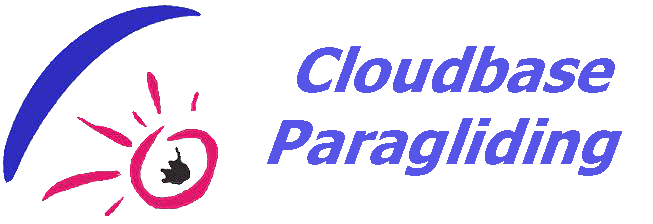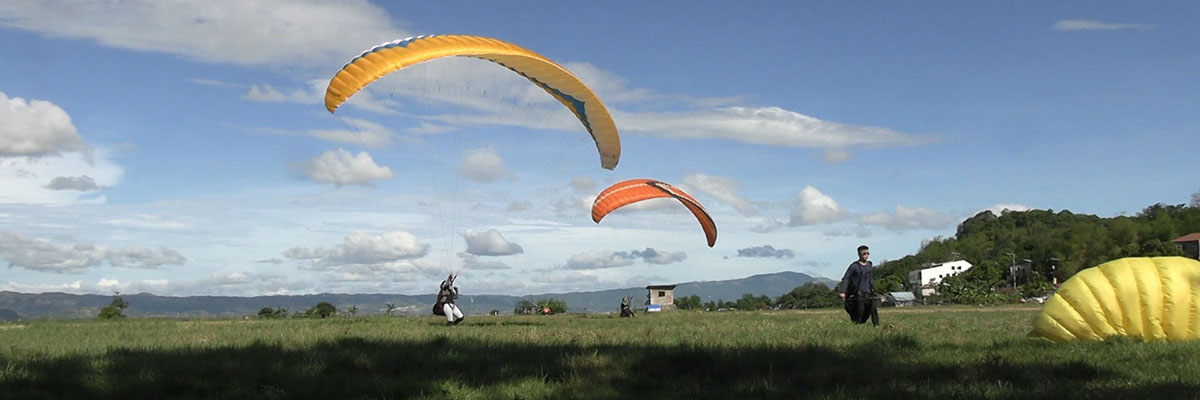Paragliding Solo Pilot courses
We are offering several training courses that you can learn safely and easily
PG1
Beginner course. Providing how to take off, landing, and basic control
5 days
35,000p
PG2
This cours providing more on technical flying so that you can fly higher and longer
5 days
35,000p
PG 1+2
This course providing together with PG1 + PG2 continously. We recommend you
10 days
60,000p
PG1 course (5 days beginner course)
You have tried a paragliding tandem flight and like it or You just like the idea of freedom and nature!
You have been dreaming of flying for years or You are just born to fly !
Whatever is your reason you can jump to training!
You will begin with ground training including launching, controlling and landing a paraglider and then you will experience your first flights from a small hill. The basic theory about aerodynamics and meteorology will give you a good understanding about how a paraglider flies and on completion of the course you will be enjoying many flights from the top of the mountain.
The main purpose of the Paragliding Beginner’s Course is to provide the foundation for enjoyable and safe flying. Close contact with your instructor will help you to overcome natural fears of height and motion.
People are different and their progress in paragliding varies but we are flexible and fit most personalities. Weather is also a key factor for all kinds of aviation but in most cases you should expect the following training program:
Day 1 : basic theory of aerodynamics and a paraglider’s construction / history / meteorology
introduction to paragliding equipment
how to set up and folding
ground practice for forward and reverse launching
controlling and landing
Day 2 : ground practice of kiting and reverse launching
how to turn around and running for launching and control
more theory of aerodynamics and introduction to micrometeorology
safety clinic for various conditions
Day 3 : repeat ground practice of take off
forward launch, learning to control the glider in the air and attempts of landing approaches;
more theory of aerodynamics and introduction to micrometeorology.
Day 4 : first flying over radio
effective turning with weight shift and braking
repeat flying for right and left turning
Day 5 : 2-4 flights over radio
improving turning and landing approach,
correcting mistakes and adding more elements to active and safe flying.
PG2 course (5 days intermediate course)
Under radio supervision and covered by solid theory you will learn new flying maneuvers and basic techniques of active flying. This will improve your skills and judgment and provide you with the necessary experience for further independent and safe flying.
The main purpose of Cloudbase Intermediate Course(PG2) is to prepare the low experience pilots for active flying and safe discovery of new horizons in paragliding.
Before starting the course you will make a demo flight from the training hill to direct us for your previous experience and where to focus on your further training.
To enroll on the Intermediate course you need to:
– be able to judge weather conditions for safe flights and to be proficient in takeoff and landing without assistance or supervision.
– be continuing straight form a Beginners course or to have had uninterrupted flying experience since the finishing of your initial training.
– have a minimum of 35 flights 5 of which from high altitude ( >300 m AGL) and mimimum of 1.5 hours of total airtime.
It is not advisable to enroll for the intermediate course if you have not flown for more than 6 months after your initial training or have had an interruption in flying for more than 2 years.
have not met the mimimal criteria for number of flights and airtime noted above.
Depending on weather and your previous knowledge and skills in most cases you should expect the following training program:
It is also a good idea to have a week of assisted flying after the intermediate course.:
Day 1 : ntroduction of Active Flying: Pitch Control. 2-4 flights from the high mountain. Simulation of pitch disturbances and accelerating the paragliders self recovery.
Day 2 : Roll Control: 2-4 flights. Simulation of roll disturbances and accelerating the paragliders self recovery
Day 3 : 2-4 flights from the high mountain; instruction in reserve parachute use; first big solo flights: development of your sense of height, speed and distance; practise of turns and landing approaches
Day 4 : Assymetric Collapses: 2-4 solo flights from the high mountain. Simulating asymmetric and frontal collapses in the air. Developing skills of active flying in turbulent conditions
Day 5 :Symetric (fontal) Collapses: 2-4 solo flights from the high mountain. Simulating symmetric and frontal collapses in the air. Developing skills of active flying in turbulent conditions.
Desent manouvers: 2-4 solo flights from the high mountain. “Big Ears”. Landing on alternative and small fields.
piral*, Excercise repetition: 2-4 flights. Performing spirals as a quick descent technique in tandem/solo based on instructors discretion. Repetition of previos excercises and consolidation of the stability techniques
Spiral dives are a complex maneouver and are not a mandatory part in the curriculum. Spiral dives are always performed first during a tandem flight and after that based on instructor discretion may be attempted solo by the student. After the completion of the course you can fly independently from different flying sites and conditions but it’s always better to look for advice from local and experienced pilots (they probably won’t refuse buying them a beer in the pub in the evening or offering them a transport to the flying site 🙂
Depending on your temper you can continue paragliding with relaxing long altitude gliding or ridge soaring flights, paramotoring, acrobatics or the eternal cross-country flying.


